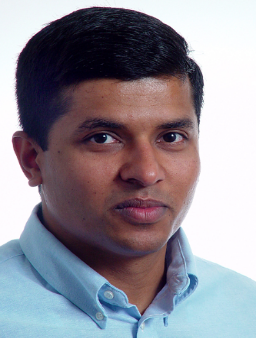Interview with Distinguished Lecturer: Professor Gaurav Sharma

Interview with Distinguished Lecturer, Professor Gaurav Sharma
 Gaurav Sharma is a professor in the Departments of Electrical and Computer Engineering, Computer Science, and Biostatistics and Computational Biology, and a Distinguished Researcher in Center of Excellence in Data Science (CoE) at the Goergen Institute for Data Science at the University of Rochester. He received the PhD degree in Electrical and Computer engineering from North Carolina State University, Raleigh in 1996. From 1993 through 2003, he was with the Xerox Innovation group in Webster, NY, most recently in the position of Principal Scientist and Project Leader. His research interests include data analytics, cyber physical systems, signal and image processing, computer vision, and media security; areas in which he has 53 patents and has authored over 220 journal and conference publications. He currently serves as the Editor-in-Chief for the IEEE Transactions on Image Processing. From 2011 through 2015, he served as the Editor-in-Chief for the Journal of Electronic Imaging and, in the past, has served as an associate editor for the Journal of Electronic Imaging, the IEEE Transactions on Image Processing, and for the IEEE Transactions on Information Forensics and Security. He is a member of the IEEE Publications, Products, and Services Board (PSPB) and chaired the IEEE Conference Publications Committee in 2017-18. He is the editor of the Digital Color Imaging Handbook published by CRC press in 2003. Dr. Sharma is a fellow of the IEEE, a fellow of SPIE, a fellow of the Society for Imaging Science and Technology and has been elected to Sigma Xi, Phi Kappa Phi, and Pi Mu Epsilon. In recognition of his research contributions, he received an IEEE Region I technical innovation award in 2008. Dr. Sharma is a 2020-2021 Distinguished Lecturer for the IEEE Signal Processing Society.
Gaurav Sharma is a professor in the Departments of Electrical and Computer Engineering, Computer Science, and Biostatistics and Computational Biology, and a Distinguished Researcher in Center of Excellence in Data Science (CoE) at the Goergen Institute for Data Science at the University of Rochester. He received the PhD degree in Electrical and Computer engineering from North Carolina State University, Raleigh in 1996. From 1993 through 2003, he was with the Xerox Innovation group in Webster, NY, most recently in the position of Principal Scientist and Project Leader. His research interests include data analytics, cyber physical systems, signal and image processing, computer vision, and media security; areas in which he has 53 patents and has authored over 220 journal and conference publications. He currently serves as the Editor-in-Chief for the IEEE Transactions on Image Processing. From 2011 through 2015, he served as the Editor-in-Chief for the Journal of Electronic Imaging and, in the past, has served as an associate editor for the Journal of Electronic Imaging, the IEEE Transactions on Image Processing, and for the IEEE Transactions on Information Forensics and Security. He is a member of the IEEE Publications, Products, and Services Board (PSPB) and chaired the IEEE Conference Publications Committee in 2017-18. He is the editor of the Digital Color Imaging Handbook published by CRC press in 2003. Dr. Sharma is a fellow of the IEEE, a fellow of SPIE, a fellow of the Society for Imaging Science and Technology and has been elected to Sigma Xi, Phi Kappa Phi, and Pi Mu Epsilon. In recognition of his research contributions, he received an IEEE Region I technical innovation award in 2008. Dr. Sharma is a 2020-2021 Distinguished Lecturer for the IEEE Signal Processing Society.
In December 2019, Prof. Gaurav Sharma visited Indian Universities as IEEE Distinguished Lecturer and delivered talks on Indian campuses under local SP Chapters of Delhi, Gujrat, and Uttar Pradesh, India. We interviewed him in the context of signal processing education and research. Below is the brief excerpt.
Q1. Please share your current research interests vis-à-vis relevance from signal processing context.
In my lab, one of the current major areas of research is on signal processing and data analytics for wearable sensors for health applications. Low-power miniaturized sensors are not only being used in in Smartphones, but also in custom packages specialized for applications in health and medicine. I see this as a strong emerging area for signal processing applications. Researchers with background in signal processing are particularly advantaged for work in this field because of their familiarity with the semantics and physical nature of the signals involved and because the right signal processing tools can be really effective. These application areas are not pure data science applications because to make sense of the measurements from the wearable sensors, a lot of preprocessing of signals is typically necessary, for which, foundational signal processing background proves very helpful. In the work we are doing in this area, we are collaborating not only with the physicians at the University of Rochester but also with a small startup company located in Boston, Massachusetts.
In addition to the analytics for wearable sensors, we also continue to work in my lab in other areas of image processing. In color imaging, we are working on multi-primary displays where, interestingly, the application is motivating new problems and questions in geometry. Additionally, we are working on deep learning for ophthalmological image analysis, where our particular focus is on leveraging conventional computer vision and image processing techniques to reduce the burden of generating annotated datasets for learning.
Q2. What challenges do you think our current student population faces as far as preparedness in signal processing is concerned?
I think one of the biggest challenges faced by us is the preparedness of students with analytical skills. In our student days, it was often easier to apply analytical reasoning and come up the answer to a question than searching for the answer because searching usually meant going to the library and finding the right book, and the right page with the information, if it existed in a book. Nowadays, the tables have turned, it is much easier to google the answer and find it than to apply the analytical reasoning. As a result, students’ analytical reasoning skills seem to be atrophying, just at the time when these skills are becoming increasing crucial for research. I have experienced this challenge while teaching the introductory signals course at the University at Rochester. One of the ways, we are trying to address this is via preparatory modules, which we call “SigPrep”, that help students to refresh the prerequisites and their analytical reasoning skills before the start of the Signal and Systems Course. “SigPrep” is a set of open source modules that we are just finalizing for online release on the WeBWorK platform.
Q3. Would you like to give any suggestion to the students?
I would say that online tools are great and useful for you both as a student and as career professionals. However, as an Engineer/Scientist it is important that you also understand the basics of how these tools work. Once you understand the basics, you may use automated resources instead of having to do the grunt work in all the cases. However, I do not think any engineer should aspire to learning only how to use tools without understanding how they function and their strengths and limitations.
Q4. In your opinion, what are the some of the most exciting areas of research in signal processing for students and upcoming researcher?
I think Health and Medicine are clearly the areas where research can have a high social impact, that too internationally rather than being localized to a single nation. Because of the increase in life expectancy, there is much larger number of people who are older. This is true even in the developing world, whereas in many developed countries, it is also the case that an increasing percentage of the population is older. Technological solutions for healthcare are therefore the need of the hour. In my opinion, this is an area where signal processing has a strong role to play.

